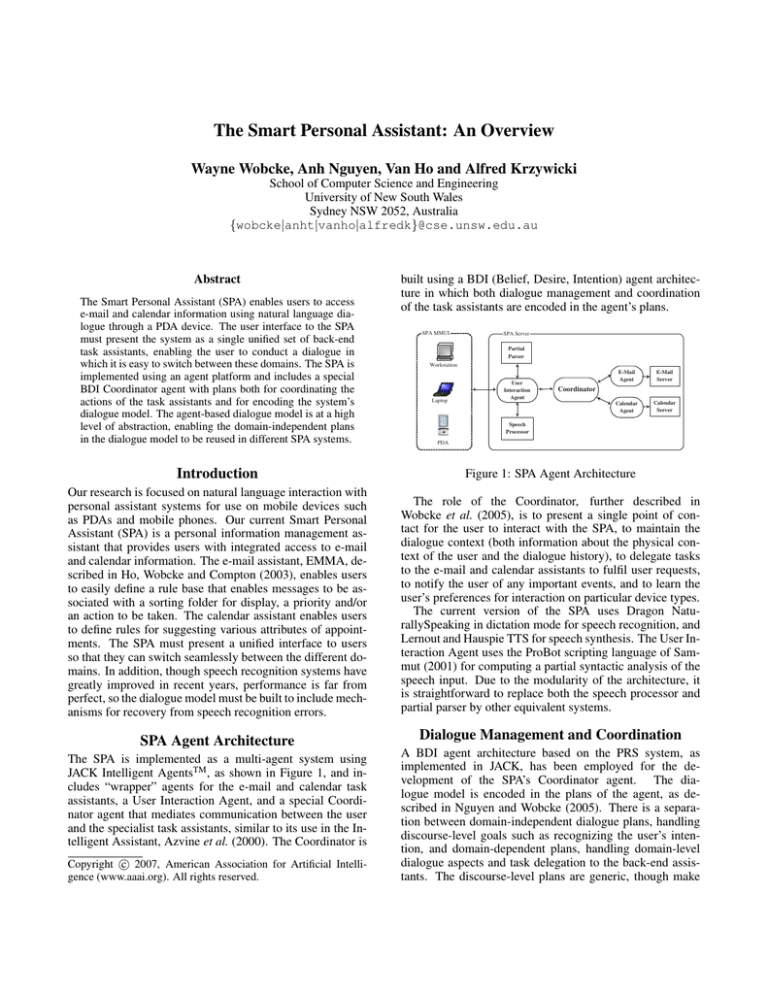
The Smart Personal Assistant: An Overview
Wayne Wobcke, Anh Nguyen, Van Ho and Alfred Krzywicki
School of Computer Science and Engineering
University of New South Wales
Sydney NSW 2052, Australia
{wobcke|anht|vanho|alfredk}@cse.unsw.edu.au
Abstract
The Smart Personal Assistant (SPA) enables users to access
e-mail and calendar information using natural language dialogue through a PDA device. The user interface to the SPA
must present the system as a single unified set of back-end
task assistants, enabling the user to conduct a dialogue in
which it is easy to switch between these domains. The SPA is
implemented using an agent platform and includes a special
BDI Coordinator agent with plans both for coordinating the
actions of the task assistants and for encoding the system’s
dialogue model. The agent-based dialogue model is at a high
level of abstraction, enabling the domain-independent plans
in the dialogue model to be reused in different SPA systems.
built using a BDI (Belief, Desire, Intention) agent architecture in which both dialogue management and coordination
of the task assistants are encoded in the agent’s plans.
SPA MMUI
SPA Server
Partial
Parser
Workstation
Laptop
User
Interaction
Agent
E-Mail
Agent
E-Mail
Server
Calendar
Agent
Calendar
Server
Coordinator
Speech
Processor
PDA
Introduction
Figure 1: SPA Agent Architecture
Our research is focused on natural language interaction with
personal assistant systems for use on mobile devices such
as PDAs and mobile phones. Our current Smart Personal
Assistant (SPA) is a personal information management assistant that provides users with integrated access to e-mail
and calendar information. The e-mail assistant, EMMA, described in Ho, Wobcke and Compton (2003), enables users
to easily define a rule base that enables messages to be associated with a sorting folder for display, a priority and/or
an action to be taken. The calendar assistant enables users
to define rules for suggesting various attributes of appointments. The SPA must present a unified interface to users
so that they can switch seamlessly between the different domains. In addition, though speech recognition systems have
greatly improved in recent years, performance is far from
perfect, so the dialogue model must be built to include mechanisms for recovery from speech recognition errors.
The role of the Coordinator, further described in
Wobcke et al. (2005), is to present a single point of contact for the user to interact with the SPA, to maintain the
dialogue context (both information about the physical context of the user and the dialogue history), to delegate tasks
to the e-mail and calendar assistants to fulfil user requests,
to notify the user of any important events, and to learn the
user’s preferences for interaction on particular device types.
The current version of the SPA uses Dragon NaturallySpeaking in dictation mode for speech recognition, and
Lernout and Hauspie TTS for speech synthesis. The User Interaction Agent uses the ProBot scripting language of Sammut (2001) for computing a partial syntactic analysis of the
speech input. Due to the modularity of the architecture, it
is straightforward to replace both the speech processor and
partial parser by other equivalent systems.
SPA Agent Architecture
The SPA is implemented as a multi-agent system using
JACK Intelligent AgentsTM , as shown in Figure 1, and includes “wrapper” agents for the e-mail and calendar task
assistants, a User Interaction Agent, and a special Coordinator agent that mediates communication between the user
and the specialist task assistants, similar to its use in the Intelligent Assistant, Azvine et al. (2000). The Coordinator is
c 2007, American Association for Artificial IntelliCopyright gence (www.aaai.org). All rights reserved.
Dialogue Management and Coordination
A BDI agent architecture based on the PRS system, as
implemented in JACK, has been employed for the development of the SPA’s Coordinator agent. The dialogue model is encoded in the plans of the agent, as described in Nguyen and Wobcke (2005). There is a separation between domain-independent dialogue plans, handling
discourse-level goals such as recognizing the user’s intention, and domain-dependent plans, handling domain-level
dialogue aspects and task delegation to the back-end assistants. The discourse-level plans are generic, though make
use of domain-specific knowledge. The modularity of this
approach enables the reuse of such discourse-level plans in
other SPA-type applications.
Figure 2 shows the overall structure of our agent-based dialogue model, in which the Coordinator’s plans are roughly
arranged into four groups according to their purpose: semantic analysis, pragmatic analysis, task processing and response and clarification generation. Each group itself contains several plans. The system contains roughly 40 plans,
including 20 discourse-level plans and six domain-specific
plans for each task domain (plus some auxiliary plans). The
main point is that dialogue processing is performed automatically as the result of the BDI interpreter selecting and
executing plans according to the current context.
INPUT
Graphical
Actions
OUTPUT
Sentences
Utterances
Partial
Parser
Speech
Recognizer
Sentences
Graphical
Actions
Response
and
Clarification
Generation
Pragmatic
Analysis
Salient
List
Domain
Knowledge
User
Model
Task
Processing
Task
Processing
User
SPA
User
SPA
User
SPA
User
SPA
User
SPA
Is there any new mail from John?
You have two new messages from John Lloyd.
Show me the one about slides please.
Displays correct message from John Lloyd.
I need to see him at 5pm tomorrow about the slides.
Do you want to enter that appointment to calendar?
Yes, enter it to the Research category.
Where are you going to meet him?
My office.
Appointment has been created.
Displays calendar showing new appointment.
Coordinator
Task assistant
The Smart Personal Assistant provides natural language interaction tailored to the user’s device, and coordination of
a range of specialist task assistants. The architecture is a
BDI architecture with plans for coordination and dialogue
actions, and point-to-point communication between agents.
The agent-based approach provides a high degree of modularity, making the domain-independent aspects of the dialogue model reusable across applications. The agent-based
approach also makes it possible to integrate learning into the
system so that the user’s preferences for interaction can be
acquired automatically.
References
.....
Task assistant
The following shows a simple scenario in which the user
checks e-mail and creates an appointment using speech interaction over a PDA. Actions of the SPA corresponding to
points in the dialogue are written in italics.1
Conclusion
TTS
Engine
Semantic
Analysis
Discourse
History
Utterances
Scenario
...
Figure 2: Agent-Based Dialogue Model
The Coordinator maintains the dialogue model, including
the conversational context and other domain-specific knowledge as its internal beliefs, as follows:
• Discourse History: for maintaining the conversational
context such as information about the current and past dialogue states.
• Salient List: for maintaining a list of objects which have
been mentioned previously in the conversation, i.e. the objects that are in the focus of attention.
• Domain-Specific Knowledge: includes domain-specific
vocabulary and information of the tasks that are supported, used in interpreting the user’s requests.
• User Model: for maintaining information about the user
such as current device, preferred modality of interaction,
physical context, preferences, etc.
As we have shown in Nguyen and Wobcke (2006), learning can be incorporated into the plan selection process of the
Coordinator so that the agent can select the most suitable
plan amongst those applicable, enabling the SPA to tailor
its responses according to the conversational context and the
user’s physical context, device and preferences.
Azvine, B., Djian, D., Tsui, K. C. and Wobcke, W. R. 2000.
The Intelligent Assistant: An Overview. In Azvine, B.,
Azarmi, N. and Nauck, D. D., eds., Intelligent Systems and
Soft Computing. Berlin: Springer-Verlag.
Ho, V. H., Wobcke, W. R. and Compton, P. J. 2003.
EMMA: An E-Mail Management Assistant. In Proceedings of the 2003 IEEE/WIC International Conference on
Intelligent Agent Technology, 67–74.
Nguyen, A. and Wobcke, W. R. 2005. An Agent-Based
Approach to Dialogue Management in Personal Assistants.
In Proceedings of the 2005 International Conference on
Intelligent User Interfaces, 137–144.
Nguyen, A. and Wobcke, W. R. 2006. An Adaptive PlanBased Dialogue Agent: Integrating Learning into a BDI
Architecture. In Proceedings of the Fifth International
Joint Conference on Autonomous Agents and Multiagent
Systems, 786–788.
Sammut, C. A. 2001. Managing Context in a Conversational Agent. Electronic Transactions on Artificial Intelligence 5(B):189–202.
Wobcke, W. R., Ho, V. H., Nguyen, A. and Krzywicki, A.
2005. A BDI Agent Architecture for Dialogue Modelling
and Coordination in a Smart Personal Assistant. In Proceedings of the 2005 IEEE/WIC/ACM International Conference on Intelligent Agent Technology, 323–329.
1
A more sophisticated scenario is shown in the video at
http://www.cse.unsw.edu.au/˜wobcke/spa.mov.






